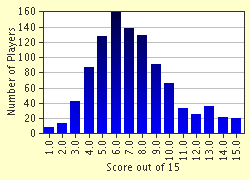Quiz Answer Key and Fun Facts
1. What two-engined bomber was Germany's "Jack of All Trades?
2. Which Luftwaffe fighter aircraft's performance fell off signifigantly above 25,000 feet?
3. The Heinkel 177 heavy bomber had the official designation of "Greif" meaning Griffon.
4. What was the only biplane still in operation in frontline attack squadrons in Germany in 1944?
5. The Arado 232 transport aircraft had many inboard wheels which, when the aircraft was lowered onto them, made loading the aircraft much easier. The aircraft was christened what as a result of these many wheels?
6. When the War ended Germany had quite a few interesting projects. One of the most desperate of these was the Bachem 349 "Natter". What about the Ba349's landing gear made it so interesting?
7. Emil Lang shot down 18 Soviet planes in one day during the war in the Soviet Union. Treu/False: for a while the record was 17 aircraft in a single day, accomplished by Hans Joachim Marseille.
8. At first, German fighter pilots were weary of the new FW-190 D-9. The main reason was that the engine used in the plane was originally designed for bombers. What was the engine?
9. The Me-410 "Hornisse" (Hornet) was a heavy fighter designed from the less than successful Me-210. The '410's main role was that of a bomber destroyer, however it had to stay out of range of the bombers' guns, so a very heavy long range gun was developed. One hit from this gun would literally obliterate a B-17 or B-24. What was this formidable weapon called?
10. During the first day of Operation Barbarossa the Soviets admitted losses of over 1200 aircraft, most on the ground.
11. Operation Bodenplatte was a highly successful German operation that temporarily returned the skies to the Germans in and around the Paris area.
12. What was the longest ranging aircraft produced in Germany during the war of these listed below?
13. Successor to the He-112, this aircraft was also turned down by the RLM (Reichs Luftwaffe Ministerium) for improved variants of the Bf-109.
14. The MiG series fighters 15-21 resemble a prototype German fighter developed by Kurt Tank. What was the designation of this aircraft?
15. How did Hermann Goering, chief of the Luftwaffe die?
Source: Author
experten45
This quiz was reviewed by FunTrivia editor
bloomsby before going online.
Any errors found in FunTrivia content are routinely corrected through our feedback system.


